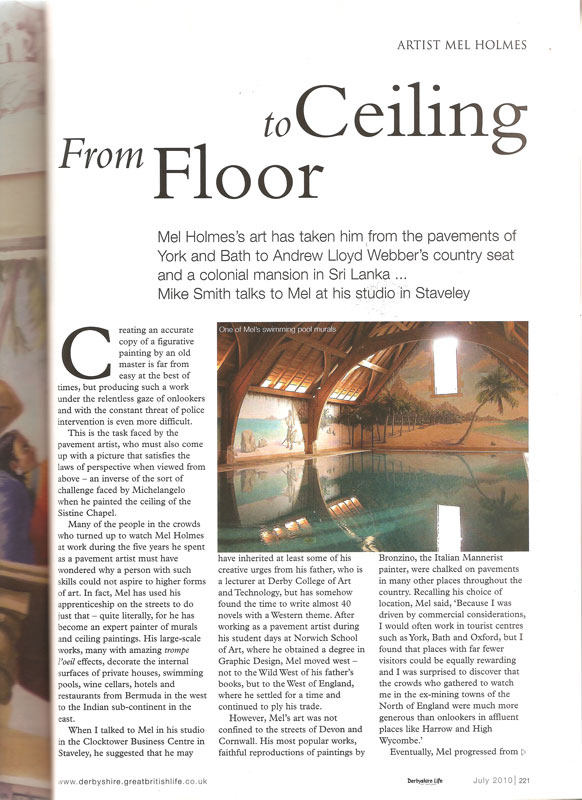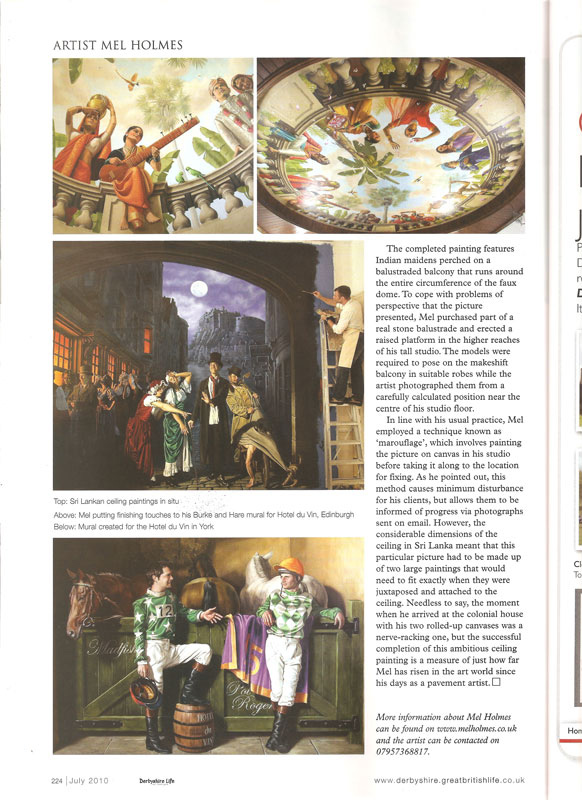
Here’s an article on my murals for Derbyshire Life magazine:
Mel Holmes’s art has taken him from the pavements of York and Bath to Andrew Lloyd Webber’s county seat and a colonial mansion in Sri Lanka.. Mike Smith talks to Mel at his studio in Staveley.
Creating and accurate copy of a figurative painting of an old master is far from easy at the best of times, but producing such a work under the relentless gaze of onlookers and with the consonant threat of police intervention is even more difficult.
This is the task faced by the pavement artist, who must also come up with a picture that satisfies the laws of perspective when viewed from above – an inverse of the sort of challenge by Michaelangelo when he painted the ceiling of the Sistine Chapel.
Many of the people in the crowds who turned up to watch Mel Holmes at work during the five years he spent as a pavement artist must have wondered why a person with such skills could not aspire to a higher form of art. In fact, Mel has used his apprenticeship on the streets to do just that – quite literally, for he become an expert painter of murals and ceiling paintings. His large-scale works, many with amazing trompe l’oile effects, decorate the internal surfaces of private houses, swimming pools, wine cellars, hotels and restaurants form Bermuda in the west to the Indian sub-continent in the east.
When I talked to Mel in his studio in the Clocktower Business Centre in Staveley, he suggested that he may have inherited at least some of his creative urges from his father, who is a lecturer at Derby College of Art and Technology, but has somehow found the time to write almost 40 novels with a Western theme. After working as a pavement artist during his student days at Norwich School of Art, when he obtained a degree in graphic design, Mel moved west – not to the Wild West of his father’s books, but to the West of England, where he settled for a time and continued to ply his trade.
However Mel’s art was not confined to the streets of Devon and Cornwall. His most popular works, faithfully reproductions of paintings by Bronzino, the Italian Mannerist painter, were chalked onto the pavement in many other places throughout the country. Recalling the choice of location, Mel said, ‘Because I was driven by commercial considerations, I would often work in tourist centres such as York and, Bath and Oxford. but I found that places with far fewer visitors could be equally rewarding and I was surprised to discover that the crowds who gathered to watch in the ex-mining towns of the North of England were much more generous than onlookers in affluent places like Harrow and High Wycombe.’
Eventually, Mel progressed from pavement art to works on canvas, mostly copies of paintings of old masters which he produced for sale in galleries. He then landed a job as a muralist and trompe l’oile painter for the Grand Union Designs Company, with the promise of major commission to produce a series of murals for the Trafford Centre, the huge shopping complex on the west of Manchester. After working on this project for a year, he was poached by two very illustrious clients from the world of music: Andrew Lloyd Webber and Robbie Williams.
Mel was invited to Sydmonton Court, Andrew Lloyd Webber’s country seat in Berkshire, and asked to produce murals for a grand staircase. Part of the tasks was to decorate the walls in the style of William Morris so that they would complement the composer’s vast collection of pre-Raphaelite art. An even grander commission ensued when Mel was summoned to Compton Basset House in Wiltshire and asked to create murals for the mansion’s indoor swimming pool. The house was bought by Robbie Williams and Mel went on to decorate all of its 19 rooms, a huge undertaking that required him to live in the house for 18 months.
These country house commissions were followed by countrywide tasks for the owner of the Hotel du Vin chain, who employed Mel to produce murals for boutique and luxury hotels in various landmark locations. The brief which was to create pictures that would reflect the character of the area in which each hotel is located, was sufficiently loose for the mural artist to make considerable use of his imagination. For example, his mural for the Hotel du Vin in Edinburgh features the city’s notorious body-snatchers, Burke & Hare, as well as the Scottish capital’s most famous dog, Greyfriars Bobby, which is shown playfully tugging at the cloak of one of the villains to reveal a concealed body part to a couple of horrified female onlookers. Burke and Hare mural.
Explaining that he has been unable to find authentic images of the two body-snatchers, Mel said ‘I used my brother and a friend as models for Burke and Hare. The exposed body part is a painting of my own arm and the shocked observers were modelled by my partner Nancy and one of her friends. In fact I often use images of people I know when I’m painting figurative paintings, in order to save money on hiring models: family and friends posed as spectators for a regatta scene which I painted for the Hotel du Vin in Poole and I feature as one of the jockeys in a stable scene I produced for the Hotel du Vin in York.’
However, Mel was unable to use acquaintances as models when he was asked by the Adamson family to paint a “Guest for Dinner” mural for Hardwick Hall Hotel near Sedgefield, because he was informed that the dinner guests should consist of proprietor Michael Adamson, and managing director John Adamson, together with long-serving employees Rita and Martin Geronimo, members of the local racing fraternity and various regulars, including non other than ex-prime minister and local MP Tony Blaire.
Click to enlarge.
Mel told me he had to advertise for young women of Indian origin to act as models for his most recent project, which is an enormous painting that includes female characters similar to those found in the work of the great Indian artist Raja Ravi Varma. This week including the requirement for Varma-style figures, was commissioned by the owner of a colonial mansion in Sri Lanka who wanted a ceiling painting that would look like the interior of the very grand dome that would have been added to the flat roof of his historic house if planning permission had been granted.
The completed painting features Indian maidens perched on a balustraded balcony that runs around the entire circumference of the faux dome. To cope with the problem of perspective that the picture presented, Mel purchased part of a real stone balustrade and erected a raised platform in the higher reaches of his tall studio. The models were required to pose on the makeshift balcony in suitable robes while the artist photographed them from a carefully calculated position near the centre of the studio floor.
In line with his usual practise, Mel utilised a technique known as “marouflage“, which involves painting the picture on canvas in his studio before taking it along to the location for fixing. As he pointed out, this method causes minimum disturbance for his clients, but allow them to be informed of progress via photographs sent on email. However the considerable dimensions of the ceiling in Sri Lanka meant that this particular picture had to be made up of two large paintings that would need to fit exactly when juxtaposed and fixed to the ceiling. Needles to say, the moment when he arrived at the colonial house with two rolled-up paintings was a nerve-racking one, but the successfully completion of the ambitious ceiling painting is a measure of just how far Mel has risen in the art world since his days as a pavement artist.




